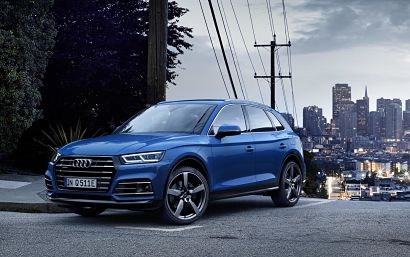
The new hybrid delivers a range of over 26 miles and a top speed of 84mph in electric-only mode enabling it to cover most everyday driving distances – including motorway journeys – without backup from the petrol engine. The new drive concept combines a 2.0 TFSI four-cylinder, turbocharged petrol engine producing 252PS and 370 Nm (272.9 lb-ft) of torque with an electric motor. Acceleration from 0 to 62mph takes 5.3 seconds; top speed is 148mph. According to the standard for plug-in hybrid vehicles, combined fuel consumption according to the WLTP cycle is 113mpg, corresponding to 49 grams CO2 per km.
The SUV’s lithium-ion battery is located under the luggage compartment floor. It is made up of 104 prismatic cells and stores 14.1 kWh of energy with a voltage of 381 volts. For optimal temperature control, its cooling loop is connected to both the coolant loop for the climate control system and the low-temperature cooling loop into which the electric motor and power electronics are also integrated. The climate control system uses a highly efficient heat pump that pools the waste heat from the high-voltage components. With 1 kW of electrical energy, it can generate up to 3 kW of thermal heating output. That makes the car more efficient and also provides a more comfortable climate for the occupants.
Particularly quiet and with zero local emissions in the city, with high range on long-distance trips or appropriately dynamic when required: the Audi Q5 55 TFSI e quattro intelligently manages a number of versatile drive modes. The concept is designed so that customers can do the lion’s share of their daily driving electrically.
Hybrid mode is activated automatically together with route guidance in the navigation system. It can also be activated manually using the Mode button. In this mode, the battery charge is optimally distributed over the route to reduce fuel consumption, with primarily electric driving in urban areas and stop-and-go traffic. The system chooses between freewheeling with the engine switched off and coasting recuperation. Coasting recuperation can recover up to 25 kW of power. The electric motor is responsible for all light braking up to 0.1 g, i.e. the majority of braking in everyday driving. A maximum of 80 kW of electrical energy are generated via braking recuperation at a deceleration of up to 0.2 g. The disc brakes are used for more power deceleration. If route guidance is active in the MMI navigation system, the predictive operating strategy attempts to drive the last urban segment of the route all-electrically and arrive at the destination with the drive battery nearly empty. The control function is based on a large amount of data. These include online traffic information, distance to the destination, the route profile of the chosen route, precise information about immediate surroundings from the navigation data, such as speed limits, types of roads, uphill and downhill slopes and the latest data from the onboard sensors.
Besides Hybrid mode, the driver can also choose between EV and Battery Hold modes. In EV mode, the car is driven exclusively electrically as long as the driver does not depress the accelerator past a variable, perceptible pressure point. EV mode is the base setting each time the vehicle is started. In Battery Hold mode, battery capacity is held at the current level.
The Audi Q5 55 TFSI e quattro is supplied as standard with the Compact charging system plus a Mode 3 cable with Type 2 plug for use at public charging stations. The Compact charging system comprises cables for household and industrial outlets plus a control unit. The system features an LED status display and safety functions such as temperature and residual current monitoring. Audi also offers an optional charging clip, a lockable wall-mounted holder for the charging system. The integrated charger charges the lithium ion battery with a maximum power of 7.4 kW. Even at a 220 V household outlet, an empty battery can be fully and conveniently recharged overnight in roughly six hours. Convenient recharging is also possible on the road.
The myAudi app allows customers to use the services from the Audi connect portfolio on their smartphones, which is particularly practical with electrified models. The app can be used to check the battery and range status, start the charging process, program the charge timer and view the charge and consumption statistics. Furthermore, the route planners in both the app and the MMI navigation in the car show charging stations.
Another function of the myAudi app is preheating/precooling prior to departure. In this case the climate control system compressor and the auxiliary heater in the car are powered electrically. The customer can determine exactly how the interior should be heated or cooled while the battery is being charged. Depending on the optional equipment chosen, the same applies to the seat and steering wheel heating, heating of the windscreen, rear window and mirrors, and the seat cooling.
The Audi Q5 55 TFSI will be available to order in the UK from early June, priced at around £55,000 OTR. First deliveries are scheduled for Q4 of this year.
For additional information:

